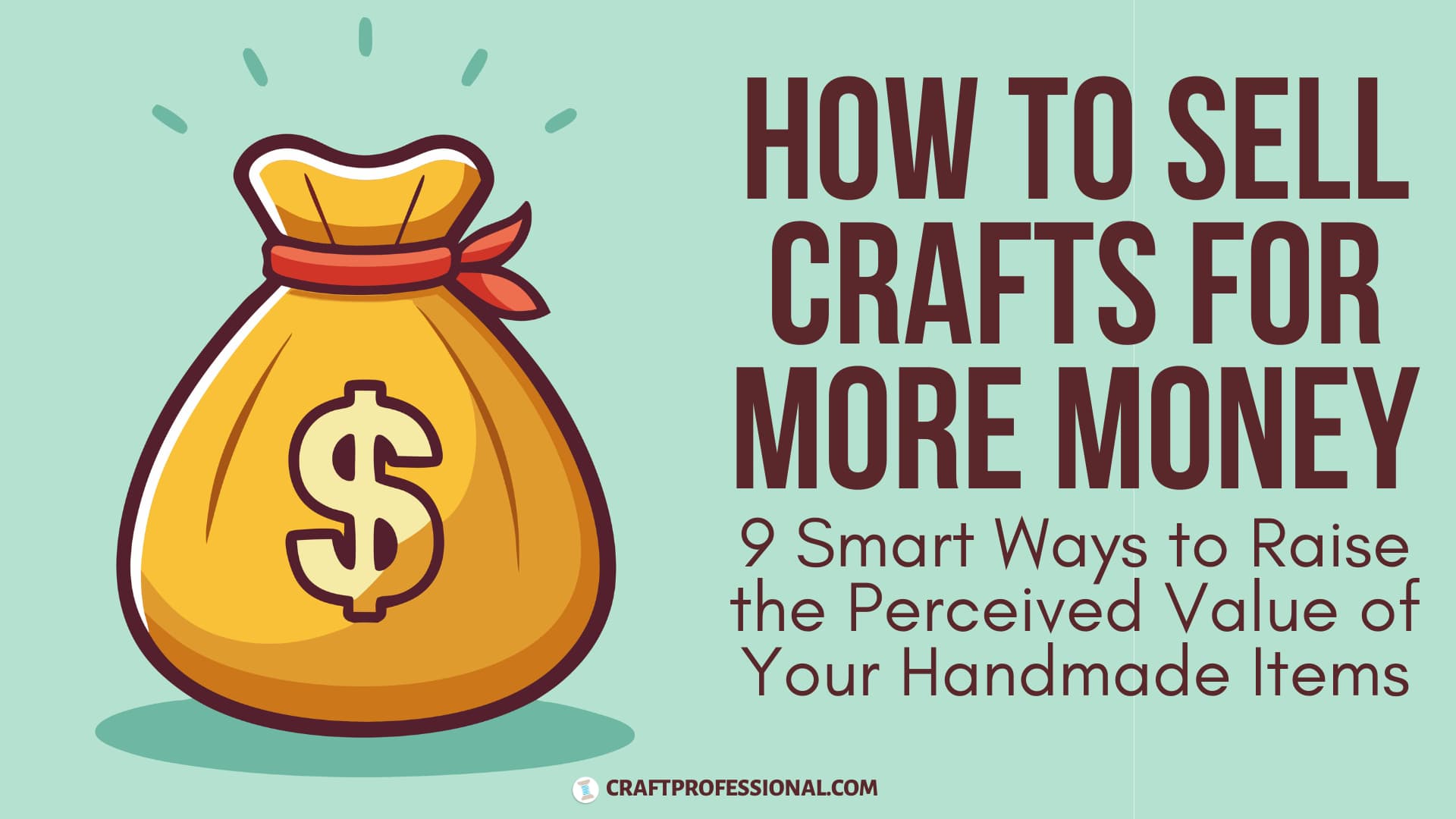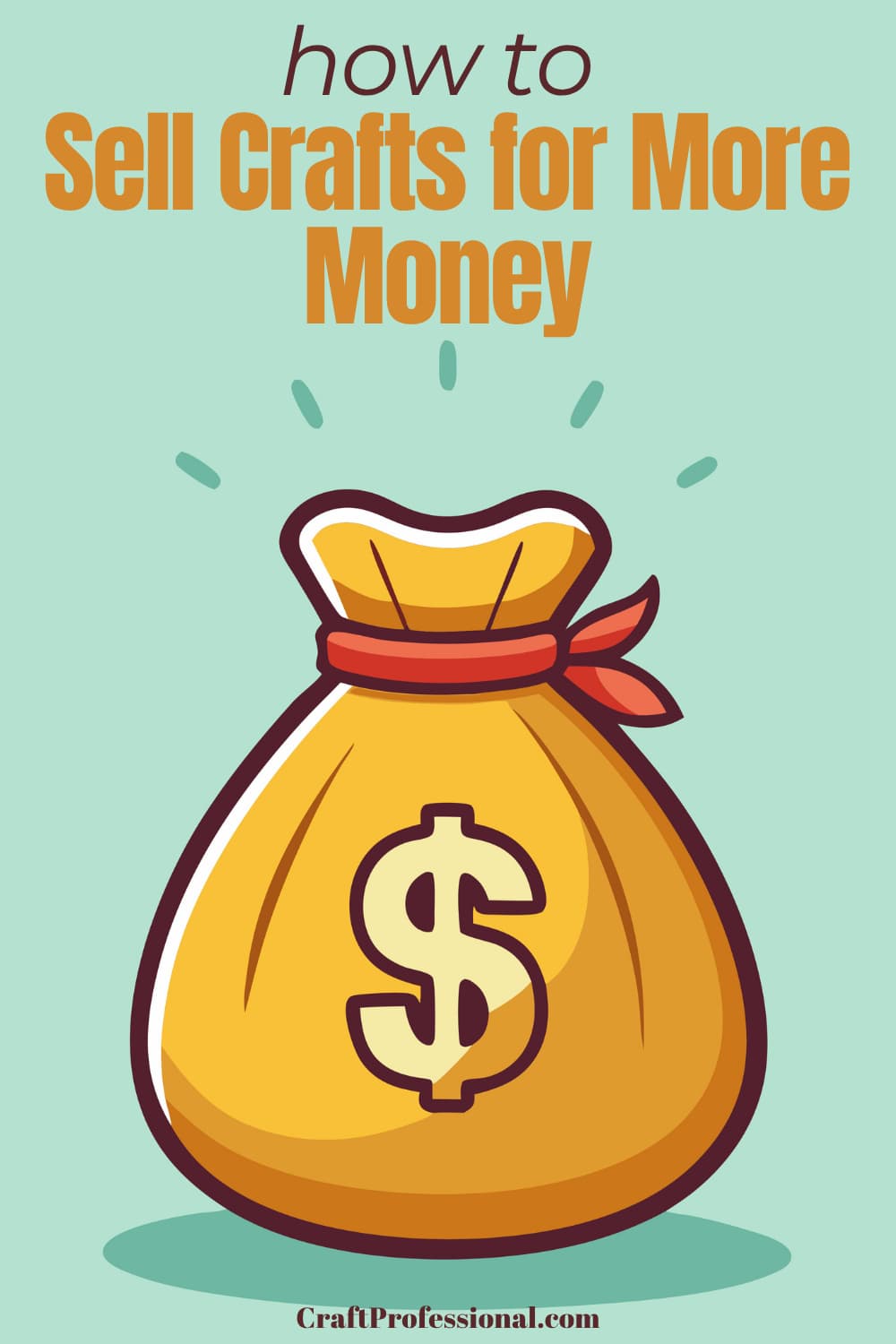- Home
- Craft Pricing
- How to Sell Crafts for More Money
How to Sell Crafts for More Money
Want to sell your crafts for more money without losing customers? The secret lies in raising the perceived value of your handmade products.
Many handmade business owners underprice their work out of fear they'll lose sales. But here's the truth: you don't have to lower your prices to compete! Instead, you need to raise the perceived value of your products.
While quality and craftsmanship are important, your customers' perception of value often plays a bigger role in how much they're willing to pay.
The good news? You can influence that perception in powerful ways.
In this guide, I'll walk you through 9 smart strategies to increase the perceived value of your handmade products, so you can confidently charge more, attract better buyers, and grow your craft business.

How to Sell Crafts for More Money
Table of Contents
What is Perceived Value, and Why it Matters
Perceived value is how much someone believes your product is worth. It's not just about cost of materials or time.
Perceived value is shaped by factors such as:
- Presentation
- Branding
- Experience
- Storytelling
- Pricing psychology
- Packaging
- Photography
- Social proof
To raise your prices, you don't necessarily need to change your product. You need to change the way your product is experienced.
Happily, these are all elements you can control!
9 Ways to Increase Perceived Value (So You Can Sell Crafts for More Money)
1. Elevate Your Product Presentation
People judge with their eyes first. Whether you sell online or in person, your product presentation has to announce "professional" and "high quality."
What to improve to send the right message:
- Use high-resolution, styled product photos with great lighting.
- Package items in gift-ready boxes, tissue paper, or eco-friendly wraps.
- Include thank-you inserts, care cards, or hand-written notes.
Before & After Tip: Take a photo of your product plain vs. staged in a setting or styled with props. You'll see instantly how much more appealing the second version feels.
2. Create a Premium Brand Story
Customers love knowing the person behind the product.
Build a brand story that communicates your passion, quality standards, and what makes your work special. That emotional connection can dramatically increase the apparent worth of your product.
Elements to consider including:
- Why you started your craft business
- What inspires your designs
- The time and skill that go into each item
- Ethical sourcing or sustainability if applicable
Example: Each of my soy candles is hand-poured in small batches using clean-burning ingredients. I started this business to help others bring calm, beauty, and intentionality into their homes.
3. Emphasize Craftsmanship and Materials
Your buyers likely don't understand how long it takes to make your product or what sets your materials apart. Educate them!
How to communicate quality:
- Add signage or product descriptions that explain premium materials or processes.
- Use phrases like "artisan-crafted," "heirloom quality," or "hand-stitched from 100% organic cotton."
- Show photos or videos of your process.
Language Example: "Each scarf is individually handwoven over 6 hours using ethically sourced alpaca wool, ensuring softness and warmth you can't get from mass-produced alternatives."
4. Price for Perception (Not Just Profit)
Yes, you should calculate your costs and desired profit margin, but your price also sends a message about value.
Oddly enough, prices that are too low can hurt you by making buyers doubt your quality.
To send a message that says quality:
- Price in the mid-to-high range for your niche
- Use rounded numbers like $40 instead of $39.95 for high-end perception
- Anchor premium products next to standard ones ("Good-Better-Best" pricing)
Pro Tip: Don't just raise your prices. Make sure your pricing reflects and communicates the value of your products.
5. Choose the Right Sales Channels
Where you sell dramatically impacts how much you can charge.
Compare these two examples:
- A handmade necklace at a church craft fair: $20–30
- The same necklace at an upscale artisan market: $60–80
Your venue affects what customers expect to pay.
Craft Fair Mistake: Selling Premium Work to Bargain Shoppers
I learned this lesson the hard way when I tried to sell my $60 handmade bracelet at the equivalent of a church craft fair, where shoppers expected $20 prices.
I had poured a lot of time and care into making the beautiful bracelet, using premium handmade boro beads, and high-quality sterling silver wire and findings.
Most of the other sellers' tables were piled with crocheted dishcloths and $5 candles. My bracelet stood out, but not in the right way.
One woman wasn't shy about showing me her displeasure at my prices. She picked up the bracelet, examined it briefly, then spotted the price tag. Her eyes narrowed. Without saying a word, she slammed it down on the table with a sharp thud that made me flinch. Then she walked away, grumbling to herself.
I didn't make a single sale that day.
That experience taught me something in a way no business book ever could: the venue matters. If you're selling premium handmade products, you need to be in places where buyers understand and appreciate their value, not where they're expecting bargains.
6. Incorporate Current Trends
Design trends boost demand, and demand boosts price tolerance.
You don't have to change up your products to follow every passing trend. Instead, highlight items that already align with current trends in:
- Colors
- Lifestyle movements
- Holidays and seasonal events
Marketing Example: "Eco-friendly gift idea for Mother's Day: handmade, zero-waste bath bombs infused with calming lavender and chamomile."
7. Know (and Target) the Right Audience
You can't sell a $60 handmade scarf to someone looking for $10 deals.
Create a clear customer profile:
- Age, gender, income level
- Values (sustainability, quality, uniqueness)
- Shopping habits (online vs. in-person, gifting vs. personal use)
Tailor your visuals and messaging to that audience, not the more price-sensitive shoppers.
8. Leverage Tourism & Local Pride
If you're in or near a tourist area, emphasize location.
Tourists love buying items with a sense of place, and they're often willing to spend more for the memory.
Strategies:
- Use raw materials sourced from your local area
- Use themes or designs that evoke something special or well-known about your location
- Offer travel-friendly items (small, durable, easy to pack)
- Create a local story behind your products
Bonus: Position products as souvenirs with soul, not mass-made trinkets.
9. Use Social Proof & Testimonials
Buyers trust buyers. Show that others love and value your work.
Ways to add social proof:
- Display reviews or thank-you notes
- Use customer photos on social or your site
- Show "best seller" or "as seen at…" labels at shows
People are more likely to pay more if they see others already have.
Want to Dive Deeper? Recommended Reading
If you're serious about growing your handmade business and pricing your crafts for real profit, I highly recommend the book, How to Price Crafts and Things You Make to Sell.
It's full of practical, sensible advice that you can read quickly and apply right away.
The book is especially helpful if you've ever struggled with pricing, finding your market, or getting your handmade work to stand out.
Final Thoughts: You Can Sell Crafts for More Money
Raising your prices doesn't have to mean losing sales. It means attracting the right buyers who see and appreciate the value you offer, so you can build a sustainable business.
Use these 9 strategies to shape perception, create desire, and position your handmade items as premium products.
You're not just selling a product. You're selling a personal story, an emotional connection, and a carefully crafted item.
And that is worth a higher price.



New! Comments
Have your say about what you just read! Leave me a comment in the box below.